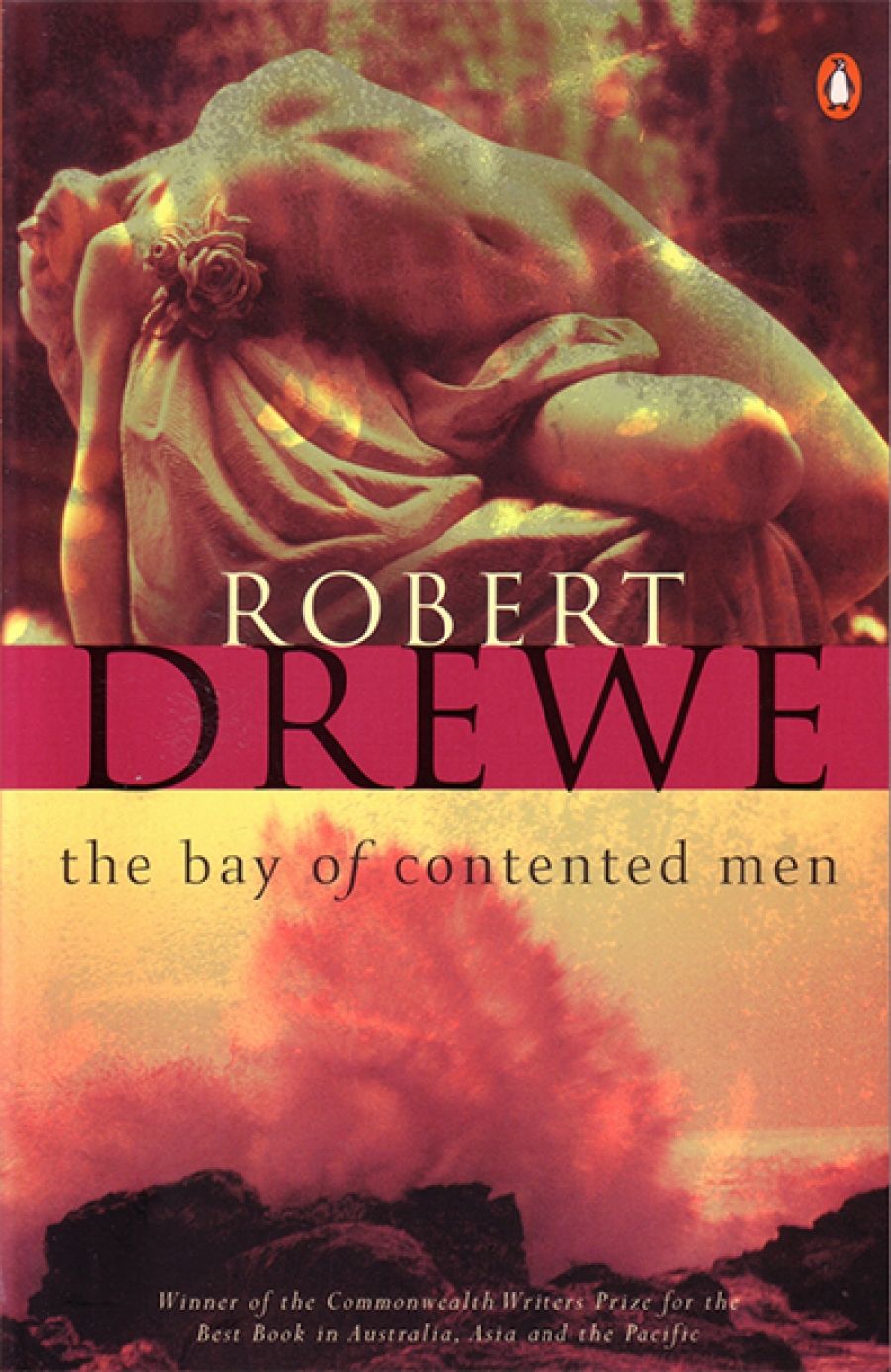
- Free Article: No
- Contents Category: Short Stories
- Review Article: Yes
- Online Only: No
- Custom Highlight Text:
‘When Australians run away, they always run to the coast.’ Robert Drewe has already debunked the myth of the bush as Australia’s heartland, and in The Bodysurfers pictured us living and loving on the very rim of the continent, precariously perched in salty, sweaty, and essentially temporary hedonistic bliss between the threat of the empty outback, the incendiary bush, and the menace of the ocean with its sharptoothed predators and secret stingers.
- Book 1 Title: The Bay of Contented Men
- Book 1 Biblio: Pan Books, $24.95 hb, $12.99 pb, 216pp, 0-330-27172-5, 0-330-27092-3pb
In Drewe’s new book of stories – another neat dozen, written as relaxation after the demands of his latest highly acclaimed novel Fortune – Australians are still running to the coast, to beaches that are tackier six years on, where pollution nudges sand and swimmer and six-year-olds come up with used syringes on their starfish palms: ‘“Hey, look!” she says. “Junkies’ blood!”’
The Contented Men, like so many of the Bodysurfers, are family men, earthed (beached?) by partners and, particularly, children. Drewe’s epigraph comes from a biography of explorer and ethnographer Nikolai Miklouho-Maclay:
A special harmony marked relations among the inhabitants. Wives and children were treated even more gently here. These men loved their surroundings, their neighbours and themselves. In a part of the world where everyone seemed reasonably satisfied, these reached the pinnacle of content. Maclay named the group the Archipelago of Contented Men.
Drewe paints for us pictures of contentment: the family picnic by the lagoon, the hard-won suburban lawn cushioning the feet of the pregnant wife, the successful political career. But he not only constantly sabotages the contentment he sets up – the unrelated children drowned in the same lagoon, the machete (violent, incongruous, inexplicable) on the lawn, the impolite end in the motel bedroom – he also suggests that contentment is not, in the end, what we’re really after.
Story after story is luridly backlit: with bushfire light in ‘Radiant Heat’, with the spinning roof-lights of emergency vehicles in ‘The First Motel’, with Californian sunsets and rumours of African dawns, with flashing neon and badly adjusted television colour. Images of violence intrude and fascinate: the machete and its more menacing absence, a Smith and Wesson revolver making a sexual point in ‘The Hammett Spiel’. Characters play, in a way we instantly recognise, with the unease, the violence under the skin, with the possibility of inviting chaos and disaster in to pep up the contentment:
Clara (standing ankle-deep in rubbish in an empty Californian swimming pool) wants badly for it to be a coyote – and she wants the vague risk of it coming closer … Does she want the howl nearer or further away? Or does she want the howl but not the coyote?
There is often a tension in these stories between the responsibilities of love and the sneaking, half-articulated wish for anarchy. In ‘Radiant Heat’ a father foresees the possibility of drowned children: ‘Frankly, at the time, I knew the risk. It occurred to me and I swam on. Worse, I anticipated something.’ In ‘Mandalay’, a husband, sensing a fault-line in his marriage, rehearses life as a fortnightly father, tantalises himself with the possibilities of a more exotic future: ‘Maybe when one door is closing others open just a crack …’
From positions of safety – on the beach, in the ersatz American motel room, at the self-satisfied lawyers’ dining-table – characters glory in blood, in danger, in death (‘Do you know what Africa is? ... Africa is a charging rhinoceros’), but when death really comes, it comes typically in these stories to a man alone and naked in an impersonal hotel room.
The book is full of motifs and recurring images, the cumulative effect of which is mordantly amusing, macabrely cheerful. One is the erect penis, sheathed/unsheathed, circumcised/uncircumcised, vibrantly alive or rigorously dead. An early simile which describes beached bluebottles’ floats as ‘sharp and erect as puppies’ penises’ (‘Radiant Heat’) sets the scene; the lawnmower lady who discusses the pros and cons of circumcision as her blades slice through the springing grass adds another bizarre dimension in a tale called ‘All the Boys’ – a story, incidentally, which grows from a moment in a Bodysurfers story, ‘Looking for Malibu’, and which recalls the actual somewhat shamefacedly sensationalised death of a retired Australian politician a few years ago. The use of such topical incidents, an actual exhibition, and current social preoccupations contributes to the strong sense of time and place which is inherent in all Drewe’s work.
Within stories, too, there is a rich and often ironic interplay of words and images: the kamikaze ‘heavenly wind’ is replaced by the orchestrated farts of businessmen of a Japanese game show while an occidental barbarian prepares for self-sacrifice in the traditional manner (‘Life of a Barbarian’); the long, allusive, elusive title story plays on the words of the title and the earlier images in the book and comes to a punning climax that is right off the page.
There is more that I would like to say about The Bay of Contented Men – about the story ‘River Water’ written in the persona of an Aboriginal woman, which leaves several levels of bitterness in the mouth, about the broader scope and the more positive tone, about risks taken and trust placed in the reader … but it is probably sufficient to suggest that, although as its sequel it will seem less ground-breaking, this collection improves on The Bodysurfers.


Comments powered by CComment